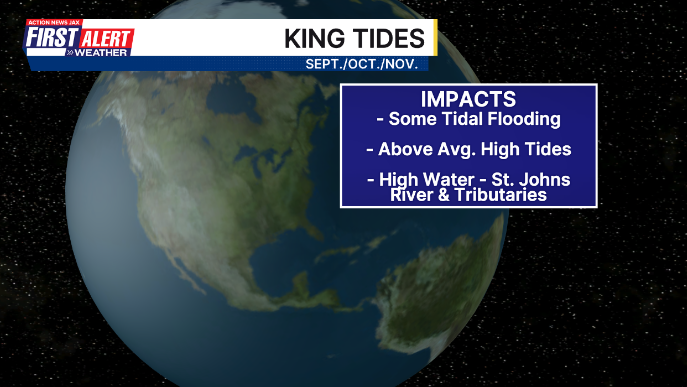JACKSONVILLE, Fla. — To become a part of the First Alert Neighborhood weather station network powered by Tempest - scan below &/or click * here *:

We are at the peak of the Atlantic hurricane season. Sept. 10th is the exact day when there is typically at least one active tropical cyclone somewhere over the Atlantic, Caribbean &/or Gulf (but not this year!). More than half of all Atlantic named storms form from late Aug. through September through the first half of October.
Updated every day throughout the hurricane season - “Talking the Tropics With Mike”.
It’s the king tide season! The king (spring) tides occur every year... since the beginning of time! These are higher than average tides that cause some nuisance type flooding, especially during times of high tide. King tides are a product of the moon’s closest proximity to earth (perigee) in Sept., Oct. & Nov. & are augmented by the full moon phase (& to a lesser degree the new moon phase when the earth, sun & moon are essentially lined up) resulting in a greater gravitational pull. The tides can be even higher when the weather conditions are right (or wrong!) - strong onshore winds or winds blowing inland off the ocean... & heavy rainfall. So we’ll again have king tides the first week of Oct. & the first week of Nov.
September night skies (Sky and Telescope):
Sep. 12 (evening): The Moon, two days shy of last quarter, follows the Pleiades by about 3° above the horizon.
Sep. 13 (dusk): Look very low in the west-southwest to see Spica and Mars 2° apart. Binoculars will enhance the view, but you’ll have to be quick to catch this sight before the star-planet duo sink out of view.
Sep. 16 (morning): The waning crescent Moon in Gemini forms a near-isosceles triangle with sides of around 4° long. Jupiter is to the Moon’s lower right and Pollux to its lower left.
Sep. 19 (dawn): A tight trio comprising the lunar crescent, Venus, and Leo’s brightest light, Regulus, adorns the east-northeastern horizon.
Sep. 20–21 (night): Saturn arrives at opposition — that is, opposite the Sun in the sky) — where it shines in Pisces.
Sep. 21: A deep partial solar eclipse sweeps across New Zealand, the south Pacific, and Antarctica.
Sep. 22: Autumn begins in the Northern Hemisphere at the equinox, at 2:19 p.m. EDT (11:19 a.m. PDT).
Sep. 27 (dusk): Look toward the south-southwest to catch the sight of the waxing crescent Moon 3° left of Antares, the celestial Scorpion’s heart.
Oct. 5 (dusk): The waxing gibbous Moon 2° to the upper left of Saturn, a view that’s more dramatic as twilight deepens.
Oct. 9 (evening): The waning gibbous Moon and the Pleiades rise together. The Moon’s light will overwhelm the scene, but binoculars should help tease out the cluster’s stars.
Moon Phases
Full Moon: September 7 2:09 p.m. EDT
Last Quarter: September 14 6:33 a.m. EDT
New Moon: September 21 3:54 p.m. EDT (partial solar eclipse - Australia, New Zealand, Antarctica)
First Quarter: September 29 7:54 p.m. EDT













